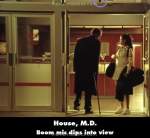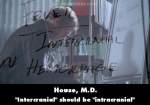Character mistake: Cameron suggests the patient is suffering from either "Buerger's disease" or "Berger's disease" (it isn't clear which she means). Foreman rejects this out of hand, since he says the patient has never been out of the USA. However, neither of those two diseases is region-specific. Buerger's disease relates to thrombosis (clotting) of arteries and veins of the hands and feet, and is associated with the use of tobacco. Berger's disease relates to kidney inflammation. Neither is region-specific. (00:33:00)

Visible crew/equipment: After a message is left on House's answering machine, when House heads back into the hospital, just as he tells Cuddy, "Great outfit," the boom mic dips into view over his head, at the top of the screen. (00:19:15)
Factual error: Given Gabriel has been in a coma for a decade, it is astonishing that once he wakes up he has no trouble speaking, and his muscles haven't atrophied at all— in fact, his muscles are remarkably toned.
Factual error: It is debatable whether Tritter has enough evidence for a court to grant civil forfeiture against House. However, the evidence absolutely wouldn't warrant (even with a sympathetic court) freezing the bank accounts of four other doctors and seizing Wilson's car. Tritter's evidence is that the doctors have prescribed House Vicodin. There's no evidence of a broader conspiracy to traffic. No court would grant this, and any lawyer (including the hospital's own lawyers) could easily challenge it.
Merry Little Christmas - S3-E10
Factual error: Wilson rolls House onto his back and leaves him lying on his back. Any doctor (especially one as good as Wilson) would never do that when there is a risk of vomiting (you can see in the background that House has already thrown up). If House were to vomit again while lying comatose on his back, he would risk choking to death on his vomit. (00:41:07)
Merry Little Christmas - S3-E10
Factual error: Tritter states he reviewed the pharmacy log and spotted the dead man's meds being collected. Regardless of Tritter's status as a cop, this is a violation of patient-physician confidentiality. No hospital would allow him log access without a court order (which he doesn't have, would take ages to be granted and requires a very high evidential threshold), and even then it is likely this work would be allocated to the DEA rather than local police like Tritter. (00:42:30)
Factual error: Chase and Foreman suggest the evidence of the pharmacy log is inadmissible at court due to patient-doctor confidentiality, but Cameron states House was neither the patient nor the doctor in question, and so confidentiality does not apply. Cameron's point is irrelevant: since the patient (who has died) and doctor in question (Wilson) did not consent to Tritter's reading the log, confidentiality still applies. As such, Tritter did not validly acquire this evidence, and it is indeed inadmissible. (00:04:18)
Whac-A-Mole - S3-E8
Factual error: There is no way that Tritter could have Wilson's bank accounts frozen on such shallow evidence. Courts require serious evidence before granting an asset freezing injunction. Given no formal charges have been filed against Wilson, they won't grant an injunction. Asset freezes are to stop someone moving money overseas/spending funds; there's no suggestion Wilson has been paid by House for the meds or might move money offshore. No court in the US will grant an asset freeze on so little evidence.
Whac-A-Mole - S3-E8
Factual error: The pharmacist refuses to provide Wilson with the medicines he has prescribed to his patients, since Tritter has had Wilson's DEA number/license suspended. However, DEA licenses/numbers are only in relation to controlled substances. Wilson is an oncologist; the chemotherapy medications he would be prescribing aren't controlled substances, and as such, not having a DEA licence wouldn't prevent him from writing scripts for these (although he couldn't prescribe any strong pain meds). (00:10:38)
Factual error: Cameron forces House (against his wishes) to do the biopsy on Foreman because Foreman has made her his medical proxy. This is completely incorrect; Cameron may be Foreman's proxy, but that doesn't mean she can overrule the attending doctor. Having the right of medical proxy allows her to *refuse* a test in Foreman's name (or refuse consent to any number of medical activities on Foreman), but absolutely not to order a test or operation contrary to the attending doctor's views. (00:34:45)
Fidelity (aka: Truth or Consequences) - S1-E7
Factual error: House rules out Lyme disease from being the cause of the sickness, since he says Lyme disease presents with a rash, which the husband would have noticed. However, although a rash is a common symptom of Lyme disease, it is by no means universal. Estimates suggest that around one-third of people with the disease don't exhibit that symptom. Doctors wouldn't therefore rule out Lyme disease solely in the absence of a rash. (00:10:25)
Continuity mistake: Chase is doing the crossword and asks Foreman what the answer to the clue "iodine deficiency in children" is. The close-up shot of the magazine shows Chase has already written the answer in (cretinism), so why is he asking Foreman the same question? Then, when Foreman gives the (same) correct answer to Chase, he writes it down - only, of course, it's already been written down. (00:02:58)

Factual error: When House is looking over his whiteboard of symptoms for the swimming patient, the symptom "Intercranial Hemorrhage" is shown on the board. However, this is an error. The correct term is "Intracranial Hemorrhage." Anything inside the head is referred to as "intra" not "inter." This is a common mistake for laypeople, however the highly trained and knowledgeable Dr. House should not have made that error. (00:31:25)
Factual error: House's team listed the potential offending organisms of the infection as "MRSA, H. Flu, VRE, and pseudomonas." House then suggests Vancomycin and Aztreonam. Vancomycin only covers gram (+) organisms and Aztreonam only covers gram (-) organisms. VRE is a gram (+) organism, thus it would not be covered by Aztreonam. VRE stands for vancomycin resistant enterococcus, thus it would not be covered by Vancomycin either. House's team therefore failed to cover for an offending organism that could have caused the infection during their initial differential. (00:09:10)
Role Model - S1-E17
Factual error: House and Foreman tell the Senator that he has toxoplasmosis, which is caused by a fungus. Toxoplasmosis is actually caused by a protozoan parasite.
You Don't Want to Know - S4-E8
Factual error: Dr. House argues that the symptoms of the patient (DIC, bleeding, and multisystem failure) can be explained by the fact that they gave him the wrong type of blood (type AB). House says the reason they could make such a mistake is that they don't test blood type, they test antibodies. Dr. Foreman responds it's because the human body only makes those antibodies when you have that type of blood. This part is incorrect. In fact, it's the exact opposite. You only produce antibodies against the antigens that you DO not have. If you did, your immune system would attack your own red blood cells (RBCs), which would cause autoimmune hemolytic anemia (aiha). For example, if your blood type is A, you make antibody B and vice versa. A person with blood type AB has A and B antigens on the RBCs, but does not produce antibodies A or B and is therefore a universal recipient. Ironically, the latter is also mentioned by Dr. Wilson in a conversation with House earlier in the episode when he says "Of course you're type AB - universal recipient. You take from everybody." House then says that the patient has blood type A, but he's making an extra antibody of type B, which led them to believe he has blood type AB and therefore give him type AB blood. House then deduces that this caused the immunologic reaction, leading to the diagnosis, SLE (lupus), which can cause acquired aiha. It's correct that giving type AB blood to a person with blood type A would cause this, but the first part is wrong. If he is type A, he is supposed to make antibody B, not antibody A, so if he were making an extra antibody, it would be antibody A, not antibody B. (00:38:20)
Character mistake: Episode 6.12, Moving the Chains: Marcus tells House that he and Eric were arrested for stealing a car, he was 16 and Eric was 14. He also says that his brother never did anything criminal after that. In season 1, we were told that Eric was 16 when he was arrested for stealing a car.
Factual error: House is playing 'Metroid: Zero Mission' on his Gameboy at various times. The Metroid series does not feature space monkeys, nor are there distinct levels. The sounds coming from the game in the show do not match it in real life, and Samus morphing into a ball is most definitely not a failure state.
Continuity mistake: As House describes the lady's symptoms, in the front shot Chase has a small book/pamphlet in his hand. The camera changes to a side shot in the middle of House's description and suddenly the book is on the table and no longer in Chase's hand. This happens right in the middle of House's line and Chase doesn't make any quick movements to account for this discrepancy.
Visible crew/equipment: In the scene where House and Allison are walking down the stairs, they round a corner and we see a dolly shot down a short hall with a glass wall in front. During this shot, a camera, cameraman, and dolly are visible in reflections on the glass. (00:08:20)






Answer: You have the right episode. The big deal at the end about the letters on the pills was to show that Brandon had the wrong pills all along. House was smiling because he was right.
MoonFaery ★